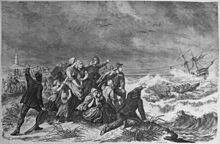Adolph Bermpohl (navigation teacher)
Friedrich August Adolph Bermpohl (born January 17, 1833 in Gütersloh ; † May 7, 1887 in Bremen ) was a German navigation teacher in Vegesack and Emden . He is considered to be the initiator of organized sea rescue services in Germany.
Life
Bermpohl attended the Friedrichs-Gymnasium in Herford, East Westphalia . In 1848, at the age of 15, Bermpohl went to sea against the wishes of his parents, who believed he should have been pastor. He took up service in the newly founded German Reichsflotte , which was under the command of Rear Admiral Karl Rudolf Brommy , and began as a cabin guard on a schooner . In 1849 he experienced an accident on a passage with a merchant ship that took him to New York and New Castle . His ship had collided with a coal-laden brig . Bermpohl survived the accident unharmed.
In 1853, after the fleet was dissolved, he completed a nautical training in Bremen. As helmsman and chief helmsman he went to sea on Bremen sailing ships. From 1859 he was a navigation teacher at the private seafaring school in Vegesack , which flourished under his aegis. In 1867 he switched to the state navigation school in Emden, and from 1870 until his retirement in 1884 he worked at the seafaring school in Bremen .

After a shipwreck near Borkum , in 1860, together with the lawyer Carl Kuhlmay, in the Vegesack weekly, he pointed out deficiencies in rescuing castaways. His "call for contributions for the establishment of rescue stations on the German islands of the North Sea" was the beginning of his commitment to the establishment of rescue stations on the North Sea . Bermpohl wrote various specialist books on seafaring. From 1860 he wrote a plethora of articles for the Vegesacker Wochenschrift , in which he castigated the so-called beach law. Under this law, goods washed up on the beach - the property of shipwrecked people - fell to the coastal residents, who had no interest in rescuing the shipwrecked. The fishermen and smallholders saw the flotsam as an additional source of income and supply. It even happened that ships were deliberately misdirected in order to continue to ensure this source; this should z. B. have happened by moving beacons .
Bermpohl promoted a non-governmental organization that was supposed to set up a sea rescue service on the basis of donations and voluntary work. In 1863 he finally founded the Bremen Association for the Rescue of Shipwrecked People , one of the forerunners of the German Society for the Rescue of Shipwrecked People (DGzRS) founded in 1865 on the initiative of Bermpohl, Georg Breusing and Arwed Emminghaus . The first chairman was the co-founder of North German Lloyd H. H. Meier .
Works
- with Arthur Breusing : Catechism of Helmsman's Art and Seamanship. Bremen 1861. Various subsequent editions, later title: Fraglehre für Seefahrtsschulen .
- English reader as well as English-German nautical dictionary together with a brief theory of forms. For use in navigation schools and for self-teaching for helmsmen. Bremen, 2nd edition 1878, 3rd edition 1886.
Honors
- In 1965, on the occasion of the 100th anniversary of the DGzRS, a new sea rescue cruiser was christened his name: Adolph Bermpohl with the daughter boat Vegesack . In 1978, Bermpohl's hometown Gütersloh took over the sponsorship of this rescue cruiser.
- In 1965 the “Marine-Verein zu Gütersloh” founded in 1906 was renamed “Marinekameradschaft Adolph Bermpohl”.
- A street in Gütersloh is named after him and there is a memorial plaque on the house where he was supposed to be born.
- A street and a pharmacy are named after him in Vegesack.
literature
- Diedrich Steilen : History of the Bremen port city of Vegesack . Vegesack 1926, pp. 111-113.
- Herbert Black Forest : The Great Bremen Lexicon . Volume: supplementary volume . A – Z. Edition Temmen, Bremen 2008, ISBN 978-3-86108-986-5 , p. 20.
| personal data | |
|---|---|
| SURNAME | Bermpohl, Adolph |
| ALTERNATIVE NAMES | Bermpohl, Friedrich August Adolph (full name) |
| BRIEF DESCRIPTION | German navigation teacher, DGzRS founder |
| DATE OF BIRTH | January 17, 1833 |
| PLACE OF BIRTH | Gutersloh |
| DATE OF DEATH | May 7, 1887 |
| Place of death | Bremen |
